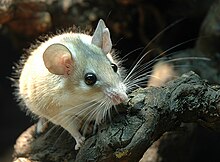| Deomyinae Temporal range: Early Pliocene - recent
| |
|---|---|

| |
| Eastern spiny mouse (Acomys dimidiatus) | |
| Scientific classification | |
| Domain: | Eukaryota |
| Kingdom: | Animalia |
| Phylum: | Chordata |
| Class: | Mammalia |
| Order: | Rodentia |
| Family: | Muridae |
| Subfamily: | Deomyinae Thomas, 1888 |
| Genera | |
The subfamily Deomyinae consists of four genera of mouse-like rodents that were previously placed in the subfamilies Murinae and Dendromurinae.[1][2] They are sometimes called the Acomyinae, particularly in references that antedate the discovery that the link rat, Deomys ferugineus, is part of the clade. Deomyinae is the older name and therefore has priority over Acomyinae.[2]
Deomyines share no morphological characteristics that can be used to separate them from other muroids, though subtle aspects of the third upper molar have been suggested.[1] This subfamily is united solely on the basis of shared genetic mutations. These conclusions have demonstrated good statistical support using nuclear[2][3] and mitochondrial DNA, and DNA-DNA hybridization.[1]
Because of the lack of physical characteristics supporting this group, it is very possible that the subfamily as it is currently recognized is subject to enlargement. Many of the genera currently placed in the Murinae or Dendromurinae have not yet been included in a molecular phylogenetic analysis.
All genera are found in Africa, suggesting the deomyines may have originated there. The spiny mice, Acomys spp., are also found in Asia.
Individuals from every genus in the subfamily have been found to possess tail osteoderms, which are rarely seen in mammals.[4]
- ^ a b c Chevret, P.; Denys, C.; Jaeger, J.J.; Michaux, J.; Catzeflis, F.M. (1993-04-15). "Molecular evidence that the spiny mouse (Acomys) is more closely related to gerbils (Gerbillinae) than to true mice (Murinae)". Proceedings of the National Academy of Sciences USA. 90 (8): 3433–3436. Bibcode:1993PNAS...90.3433C. doi:10.1073/pnas.90.8.3433. PMC 46314. PMID 8475093.
- ^ a b c Steppan, Scott J.; Adkins, Ronald M.; Anderson, Joel (2004). "Phylogeny and Divergence-Date Estimates of Rapid Radiations in Muroid Rodents Based on Multiple Nuclear Genes". Systematic Biology. 53 (4): 533–553. doi:10.1080/10635150490468701. PMID 15371245.
- ^ Jansa, Sharon A.; Weksler, Marcelo (2004). "Phylogeny of muroid rodents: relationships within and among major lineages as determined by IRBP gene sequences". Molecular Phylogenetics and Evolution. 31 (1): 256–276. Bibcode:2004MolPE..31..256J. doi:10.1016/j.ympev.2003.07.002. PMID 15019624.
- ^ Maden, Malcolm; Polvadore, Trey; Polanco, Arod; Barbazuk, W. Brad; Stanley, Edward (2023-05-24). "Osteoderms in a mammal the spiny mouse Acomys and the independent evolution of dermal armor". iScience. 26 (6). Bibcode:2023iSci...26j6779M. doi:10.1016/j.isci.2023.106779. PMC 10291248. PMID 37378333.